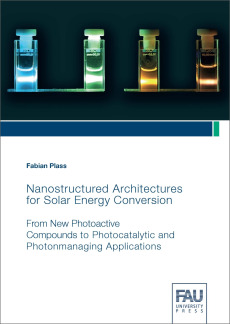Plass Fabian
Nanostructured Architectures for Solar Energy Conversion
From New Photoactive Compounds to Photocatalytic and Photonmanaging Applications
Sustainable solar energy conversion is one of the main tasks of younger human history to be able to herald a successful energy turnaround by using profitable and environmentally friendly energy sources and carriers.
The use of nanostructured architectures, such as the implementation of molecular electron donor-acceptor systems in opto-electronic applications, is a promising option. Various strategies can be pursued: On the one hand, the development of novel and promising carbon rich compounds, the fundamental characterization of those plays a major role in this PhD thesis, and, on the other hand, the development and optimization of already existing compounds of molecules and materials, whose enormous potential has perhaps not yet been fully exploited.
Moreover the combination of solar fuels such as hydrogen, as well as the use of novel, economical solar cells, but also sustainable OLEDs, will be important elements to protect life as we know it today and will make it worth living for future generations.
Nachhaltige Solarenergieumwandlung ist eine der Hauptaufgaben der jüngeren Menschheitsgeschichte, um durch den Einsatz profitable und umweltfreundliche Energiequellen und -träger eine erfolgreiche Energiewende einleiten zu können.
Der Einsatz von nanostrukturierten Architekturen, wie z.B. die Implementierung von molekularen Elektronen Donor-Akzeptor-Systemen in optoelektronischen Anwendungen, ist eine vielversprechende Option. Dabei können verschiedene Strategien verfolgt werden: Zum einen die Entwicklung neuartiger und vielversprechender kohlenstoffreicher Verbindungen, deren grundlegende Charakterisierung in dieser Dissertation eine große Rolle spielt, und zum anderen die Entwicklung und Optimierung bereits bestehender Verbindungen von Molekülen und Materialien, deren enormes Potenzial vielleicht noch nicht voll ausgeschöpft ist.
Darüber hinaus werden die Kombination von solaren Brennstoffen wie Wasserstoff sowie der Einsatz neuartiger, kostengünstiger Solarzellen, aber auch nachhaltiger OLEDs, wichtige Elemente sein, um das Leben, wie wir es heute kennen, zu schützen und für zukünftige Generationen lebenswert zu machen.
Produktinformationen
121 Seiten , Format 17,0 x 24,0FAU University Press
26,00 € inkl. MwSt.
Erscheinungsdatum
Januar 2022
Kategorie: Chemie
